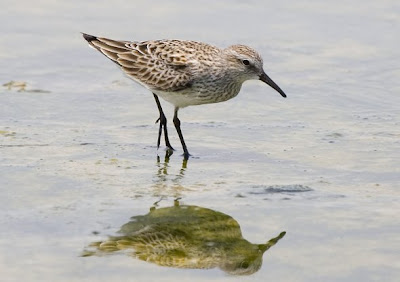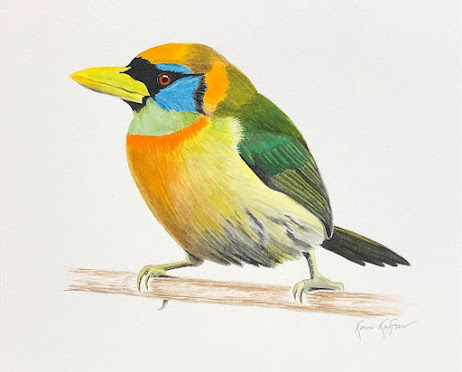Endless Spring
 Summer? Says who? For this White-rumped Sandpiper, this is still the season of spring migration.
Summer? Says who? For this White-rumped Sandpiper, this is still the season of spring migration.From the middle of a flooded field in northern Ohio, Kenn writes: After a totally crazy month, the calendar has just clicked over from May -- we call it May-hem around here -- to June. So what season is it now? If you’re a White-rumped Sandpiper, it’s still spring, still the height of northward migration season.
Of course, if you’re a White-rumped Sandpiper, you’re probably not reading this blog.
If you’re a sandpiper, you’re too busy to read things like this. Especially if you’re a White-rumped. More than three dozen different species of sandpipers are found regularly in North America; all of them are at least somewhat migratory. None of them migrates north later in spring, on average, than the White-rump.
This bird has a lot of distance to cover. Its wintering sites are all in southern South America, including some as far south as the tip of the continent -- or even farther: this amazing migrant has even been recorded in Antarctica. Its nesting sites are all in high Arctic regions of Canada and Alaska, most of them north of the Arctic Circle. So when northbound birds get to the latitude of the lower 48 states, they still have some traveling ahead of them. It’s amazing how late in the spring they show up. When I was down in Texas at the beginning of May this year, I saw a few White-rumped Sandpipers, but they were among the earlier arrivals at that location, and most would be passing through in mid-May. Here in northern Ohio, White-rumps have just shown up within the last few days. Their peak passage through here will be during the first ten days of June. Their time on the Arctic tundra may be very brief: some adults, perhaps those that have failed at their nesting attempt, will be southbound before the middle of July.
 See the obvious white rump on this bird? No, we can't see it either.
See the obvious white rump on this bird? No, we can't see it either.Birders often overlook the White-rumped Sandpiper. That may be partly because of its migration timing, slipping through after many birders have given up on spring. It’s also partly because it’s a subtle bird with few obvious field marks. Looking at the photos here, do you see any white rump patch? The bird’s namesake field mark is visible only in flight, or rarely while the bird is actively preening its feathers. Various field guides, from the second edition of Peterson’s western to some editions of the National Geographic, have illustrated this species with its wings drooped, showing off the white patch on the rump and uppertail coverts. In real life, the birds just don’t stand that way. When I see this species in spring, I usually pick it out first by its squeaky callnote, by the fine sharp streaks on the chest, and especially by the long-winged profile. Those long wings, incidentally, are a reflection of the bird’s long-distance migration.
I doubt that we can have the bird’s name changed to "Invisibly-white-rumped-and-uppertail-coverted Sandpiper," but if we called it "Long-winged Sandpiper," birders might overlook it less and appreciate it more.
Regardless, if you’re anywhere east of the Rockies, especially in the interior of the continent, early June is not too late to see the White-rumped Sandpiper in spring migration. Singles and small flocks are stopping over in all kinds of shallow wetlands, from the edges of grassy marshes to flooded farm fields. If you can find one of these subtle sandpipers, give it a salute of respect for the 8000-mile journey it has undertaken, and wish it success in getting to the tundra on time.



I remeber last year someone spotted a White-rumped Sandpiper her in Connecticut. Still be weak in the shorebird category I wasn't able to single it out on my own.-Maybe this year I'll find my own.
ReplyDeleteLovely capture,fantastic shot and a fantastic W.R.sanpiper.
ReplyDeleteWell done.
john.